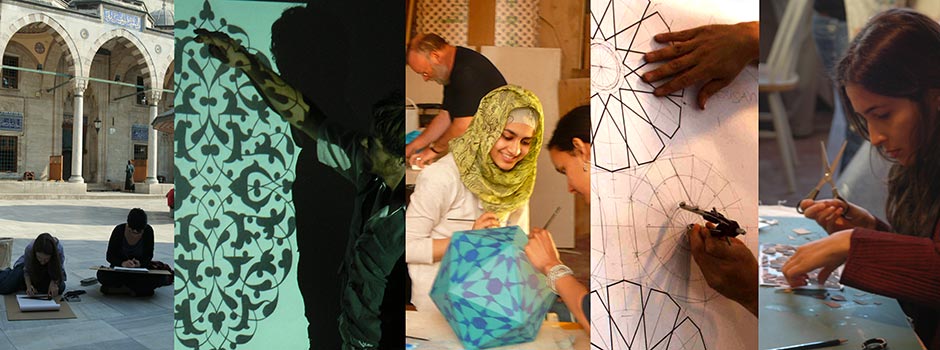
AN INTERVIEW WITH ADAM WILLIAMSON AND RICHARD HENRY, FOUNDERS OF ART OF ISLAMIC PATTERN Islamic Art Hands-On
Oct 30, 2014 Interview

There is a resurgence of interest in the traditional Islamic arts. The difficulty for artists in Europe and North America who want to learn and master the arts of illumination, geometric design or arabesque is where to find such training. Adam Williamson and Richard Henry founded their London-based educational enterprise, Art of Islamic Pattern, with this challenge in mind. It offers a variety of courses catering to different age groups and levels in the London studio and around the world, as well as special study trips to cities like Istanbul, Fez, or Granada. Williamson and Henry are both skilled craftsmen who understand the practical and philosophical aspects of Islamic pattern and design. And between them, they have taught at Birkbeck University, Cambridge University, the British Museum, Central Saint Martins, the Slade School of Fine Art and The Prince’s School of Traditional Arts where they both studied. Artists in their own right, they have each received commissions from notable public and private clients.
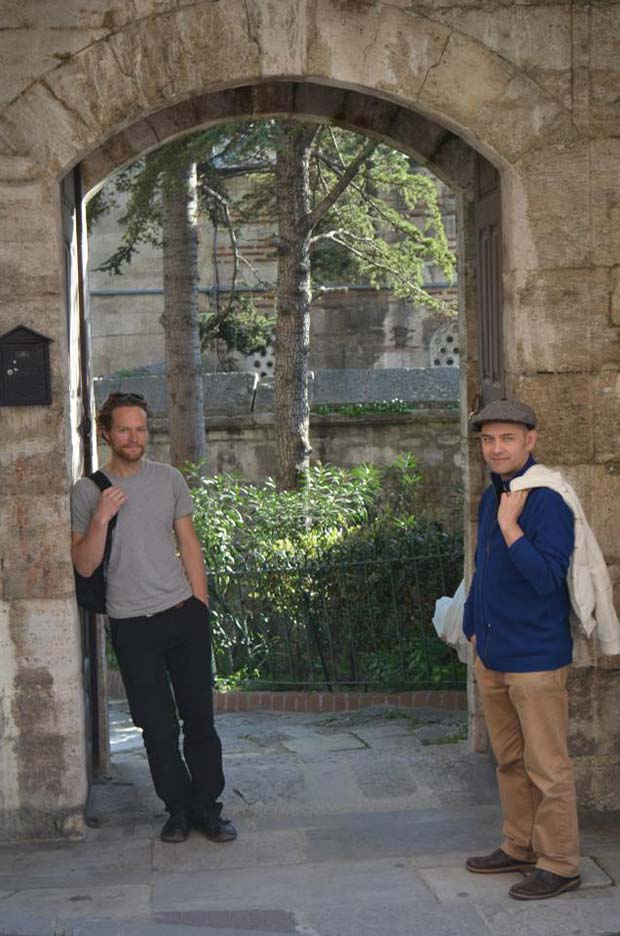 Portrait of Art of Islamic Pattern founders: Adam Williamson (left) and Richard Henry (right), Istanbul, Turkey 2014 / Courtesy of the Artists
Portrait of Art of Islamic Pattern founders: Adam Williamson (left) and Richard Henry (right), Istanbul, Turkey 2014 / Courtesy of the Artists
RH: Our courses have a specific focus upon the Islamic tradition. PSTA looks at the full sweep of world traditions. We are perhaps more with the public facing, in the sense that our courses are designed for the layperson, irrespective of background and we are not formally part of any academic institution. The PSTA is more academic in focus with courses for MA and PhD students. Many of our own students have gone onto study at PSTA.
AW: The courses are primarily practical in nature. There are contextual slide lectures, but the rest of the time students are drawing geometric and biomorphic patterns by hand or with a compass and straight edge. The final stages of courses and trips culminate with creating a work in a traditional medium.
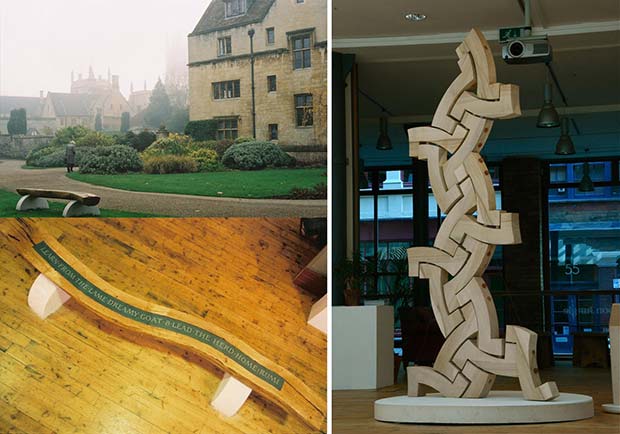 LEFT: Adam Williamson, Sculptural Bench, large twisted oak with inset curving slate carved with poetry sitting on large Portland limestone semi circular feet, Oxford University (commission), England / RIGHT: Adam Williamson, ash sculpture, Geometric Moon Jungle, 2008 / Both images Courtesy of Adam Williamson
LEFT: Adam Williamson, Sculptural Bench, large twisted oak with inset curving slate carved with poetry sitting on large Portland limestone semi circular feet, Oxford University (commission), England / RIGHT: Adam Williamson, ash sculpture, Geometric Moon Jungle, 2008 / Both images Courtesy of Adam Williamson
AW: Keith Critchlow was a great teacher who appeared in my life at the perfect time to connect the dots. His teaching methods seemed purely inspired and intuitive which gave his classes an enjoyable, unpredictable and dynamic energy.
RH: Both of us regard the face-to-face teaching of geometry and traditional art as a form of transmission from master to student. We believe that there is a contemplative dimension to the practical work, which is embodied within the shapes and proportions used. These are the fundamental principles of sacred geometry.
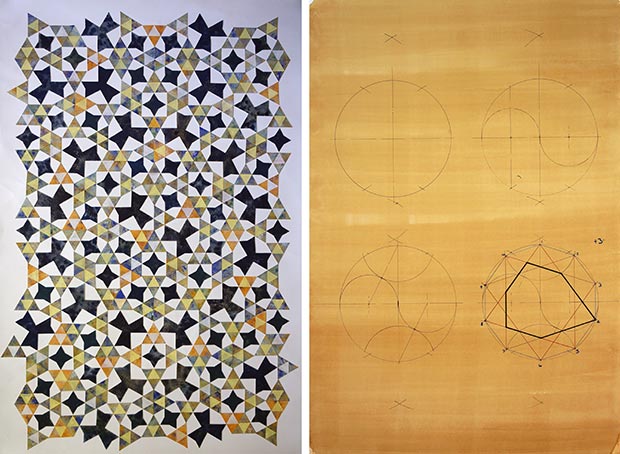 LEFT: Richard Henry, Damascene Variation, mixed media collage on paper, 120x75 cm / RIGHT: Richard Henry, Working Drawing: Progressive drawings of decagram and Girih motif, 70x50cm / Both images Courtesy of Richard Henry
LEFT: Richard Henry, Damascene Variation, mixed media collage on paper, 120x75 cm / RIGHT: Richard Henry, Working Drawing: Progressive drawings of decagram and Girih motif, 70x50cm / Both images Courtesy of Richard Henry
RH: Learning through doing is critical, it’s not simply about acquiring a critical analytical understanding of the designs. A sensitivity to the contemplative dimension of the work, both as a student and as a teacher, is essential.
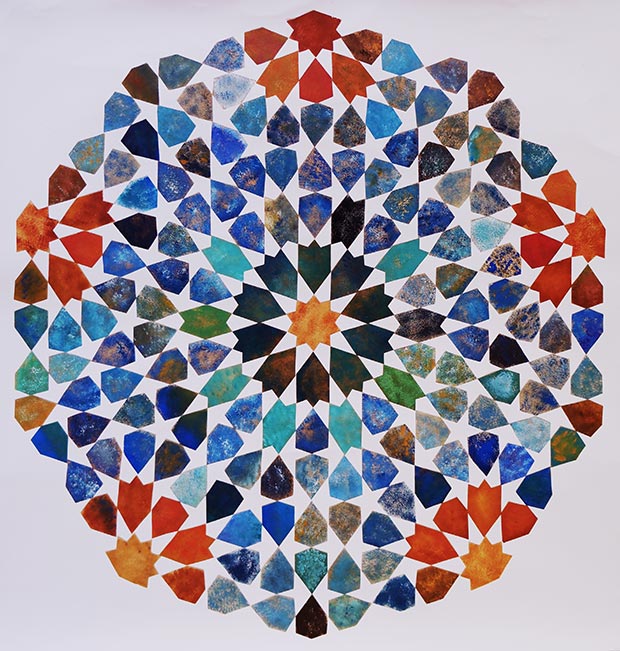 Richard Henry, Doha Girih, mixed media collage on paper, 100x100 cm / Courtesy of Richard Henry
Richard Henry, Doha Girih, mixed media collage on paper, 100x100 cm / Courtesy of Richard Henry
 Richard Henry, Girih Composition, wooden tiles (oak, cherry, walnut) with incised pattern, 50x50cm / Courtesy of Richard Henry
Richard Henry, Girih Composition, wooden tiles (oak, cherry, walnut) with incised pattern, 50x50cm / Courtesy of Richard Henry
RH: Our introductory courses and study strips assume no prior knowledge of Islamic art and are open to everyone. We generally have a mix of abilities on all of our courses and study trips. Our students come from a range of backgrounds and have a broad range of interests and motivations. Some are professional artists or designers seeking to develop a particular aspect of their work, others are from non-art backgrounds who are driven to explore the art and culture of the Islamic world more deeply and there are others who find themselves at a professional crossroads, and wish to change careers to something more creative and more personally or professionally fulfilling.
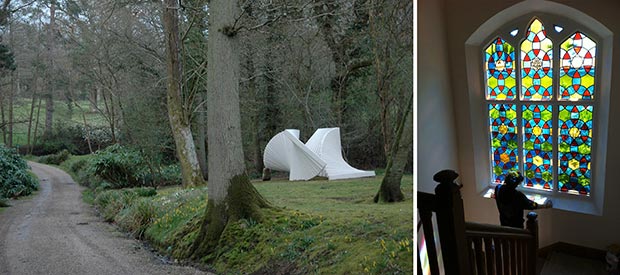 LEFT: Adam Williamson, White Sculpture, Hannah Peschar Sculpture Park, England, height, pine, 2008 / RIGHT: Adam Williamson, Stained glass window, Cambridge Muslim College (commission), England, 2012 / Both images Courtesy of Adam Williamson
LEFT: Adam Williamson, White Sculpture, Hannah Peschar Sculpture Park, England, height, pine, 2008 / RIGHT: Adam Williamson, Stained glass window, Cambridge Muslim College (commission), England, 2012 / Both images Courtesy of Adam Williamson
AW: We don’t see tradition as something historic but view it as constantly growing and developing, a way to pass down skills and knowledge. This would have been the same view held in antiquity when various structures were developed to teach, for example the guild systems used in both east and west. With the industrialization of much of the world, these systems were lost. People today have an interest in understanding and experiencing these skills, which are now difficult to access. Maybe this is why there is a lot of interest in the courses we facilitate.
 Sama Mara, Installation view of A Hidden Order, Exhibition at The Prince’s School of Traditional Arts, London, 2014 / Courtesy of the Artist
Sama Mara, Installation view of A Hidden Order, Exhibition at The Prince’s School of Traditional Arts, London, 2014 / Courtesy of the Artist
 Sama Mara, Installation view of A Hidden Order, Exhibition at The Prince’s School of Traditional Arts, London, 2014 / Courtesy of the Artist
Sama Mara, Installation view of A Hidden Order, Exhibition at The Prince’s School of Traditional Arts, London, 2014 / Courtesy of the Artist
AW: Yes, it has been a pleasure to teach on a series of outreach programs for PSTA. It was a particular highlight to work with the First Nation community of Ahousaht. I have been interested in West Coast art, especially the cedar carving, since I was a teenager.
The aspiration for this project was to allow a wider and deeper sharing of traditional knowledge through the direct language of nature, which informs art, number and geometry. The First Nations have an active relationship with nature. Experiencing and hearing about their rituals and remedies and how they are successfully applied to daily life has been an uplifting education for both myself and Lateefa.
The practical outcome of the three trips was a series craft projects, all using cedar. Cedar has always been seen by the locals as the tree of life. It is used to make cloth and rope and used in house building as well as for artwork. For the first project, we created a series of paintings on woven cedar bark. For the second project, we built a 14x24 foot cedar dome and, for the final project, we carved 50 cedar boards that were installed as part of the Flores Island Wild Side boardwalk trail.
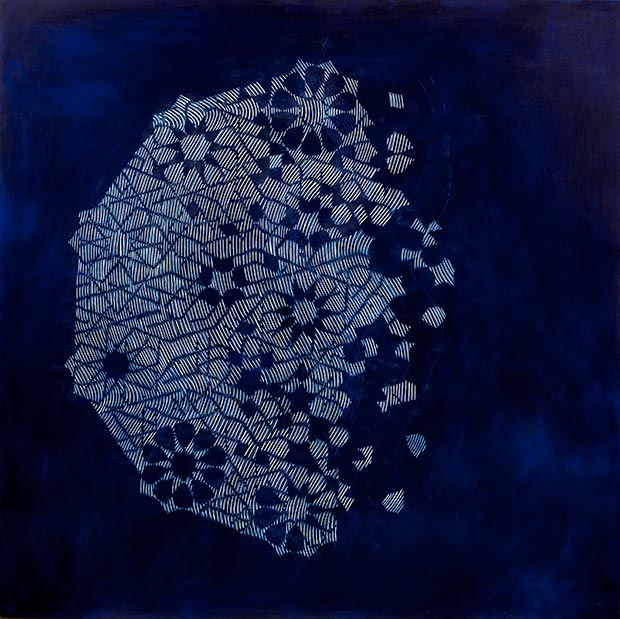 Lateefa Spiker, Geo Moon Wave, gold leaf on board, 70x70 cm / Courtesy of the Artist
Lateefa Spiker, Geo Moon Wave, gold leaf on board, 70x70 cm / Courtesy of the Artist
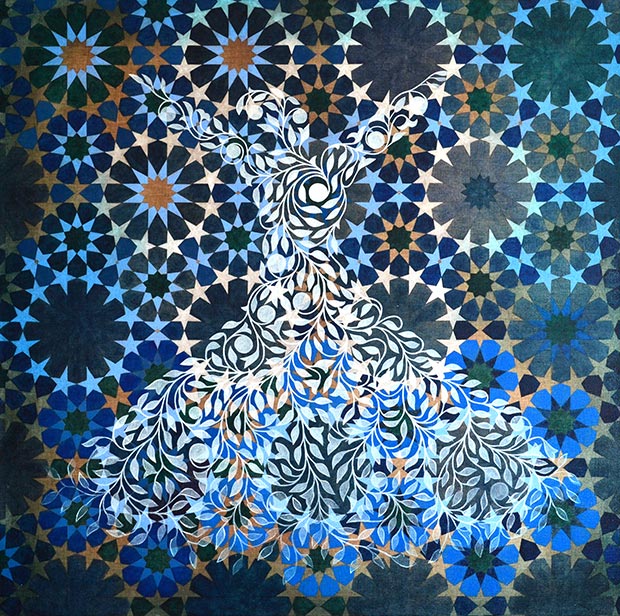 Lateefa Spiker, Whirling Arabesque, 1x1 m, gouache, acrylic and oil on canvas / Courtesy of the Artist
Lateefa Spiker, Whirling Arabesque, 1x1 m, gouache, acrylic and oil on canvas / Courtesy of the Artist
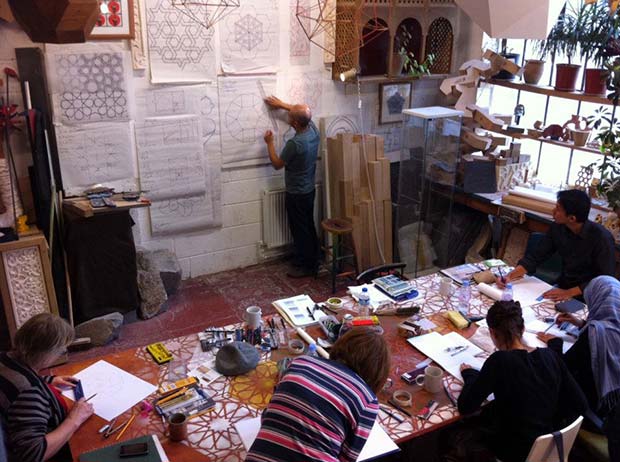 Richard Henry and students. In the Hackney studio / Courtesy of Art of Islamic Pattern
Richard Henry and students. In the Hackney studio / Courtesy of Art of Islamic Pattern
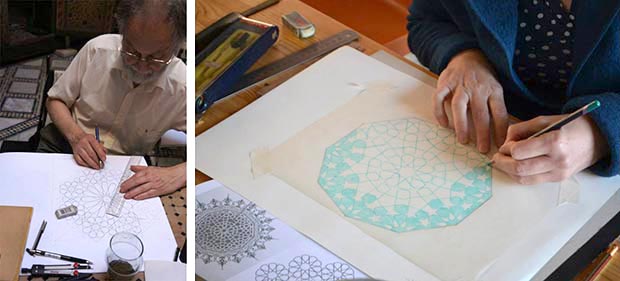 LEFT: Student (Alan Griffiths) at work, Fez, Morocco, 2013 / RIGHT: Student at work, Istanbul, Turkey 2014 / Courtesy of Art of Islamic Pattern
LEFT: Student (Alan Griffiths) at work, Fez, Morocco, 2013 / RIGHT: Student at work, Istanbul, Turkey 2014 / Courtesy of Art of Islamic Pattern
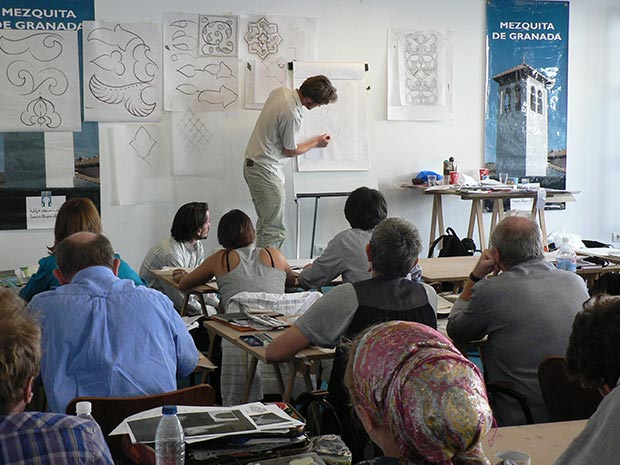 Adam Williamson and students. Granada, Spain 2010 / Courtesy of Art of Islamic Pattern
Adam Williamson and students. Granada, Spain 2010 / Courtesy of Art of Islamic Pattern
 Students at work. Dar Seffarine Fez, Morocco, 2013
Students at work. Dar Seffarine Fez, Morocco, 2013
Comments
Add a comment